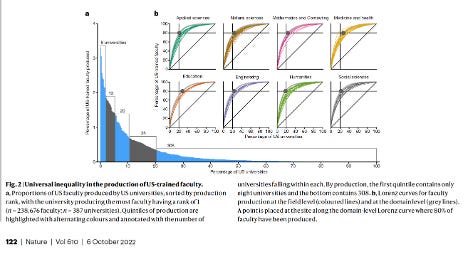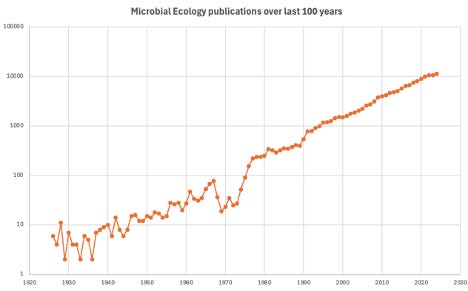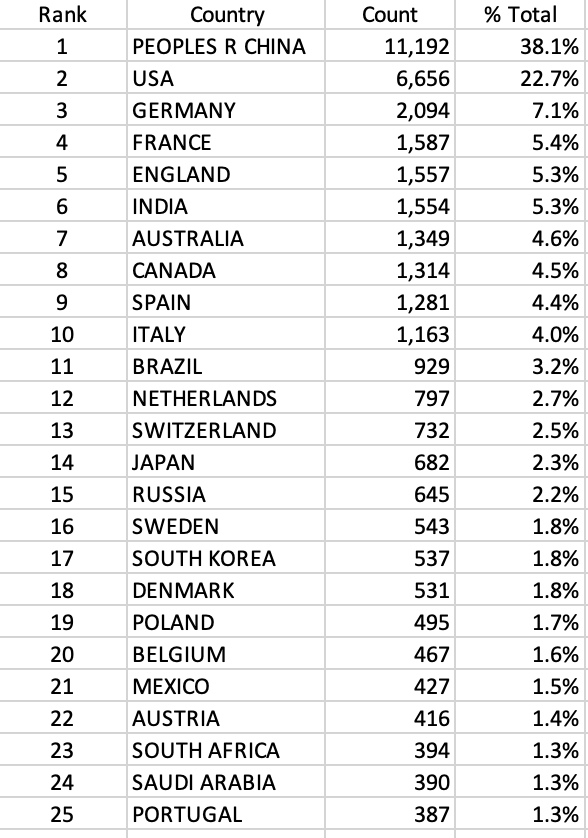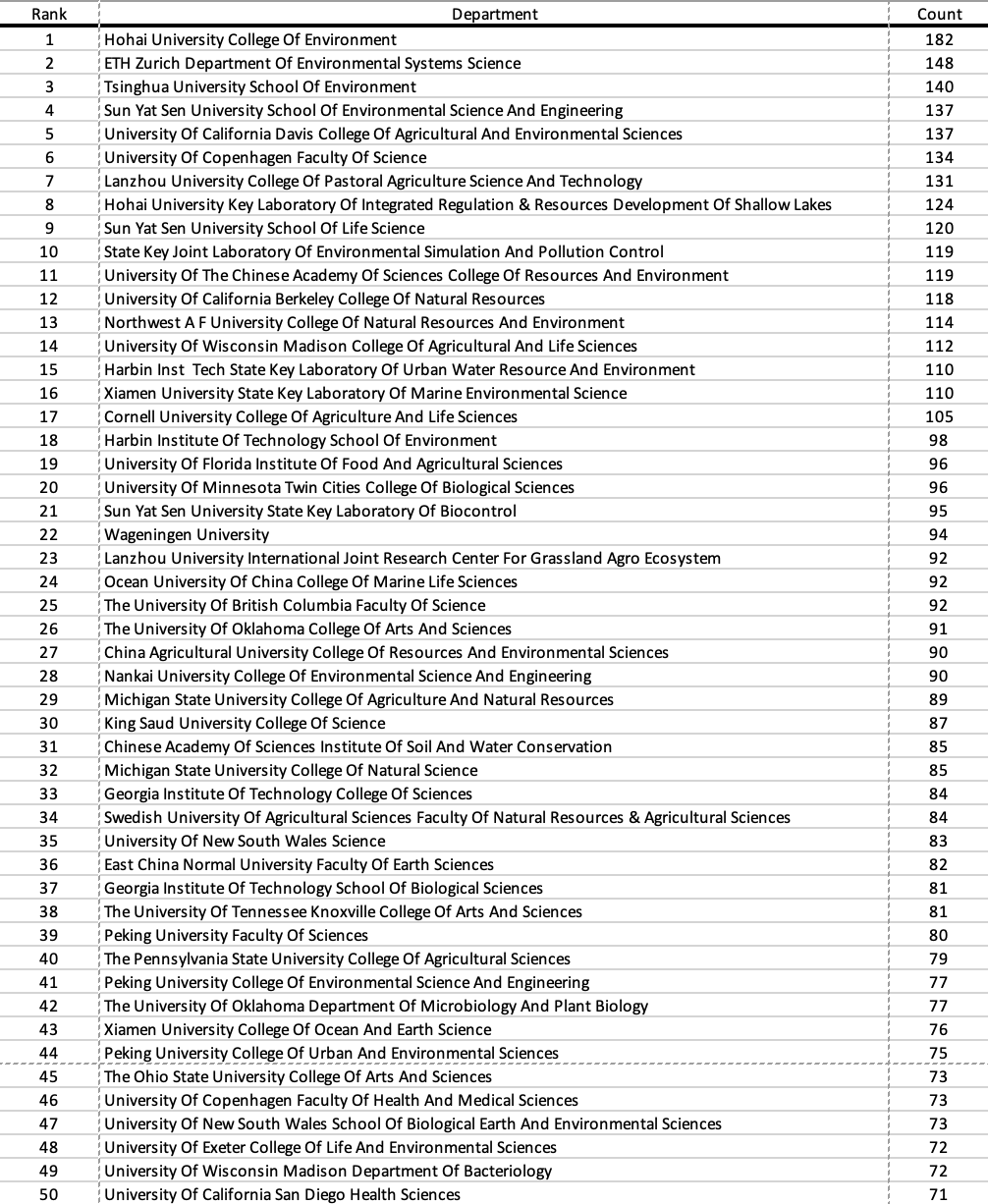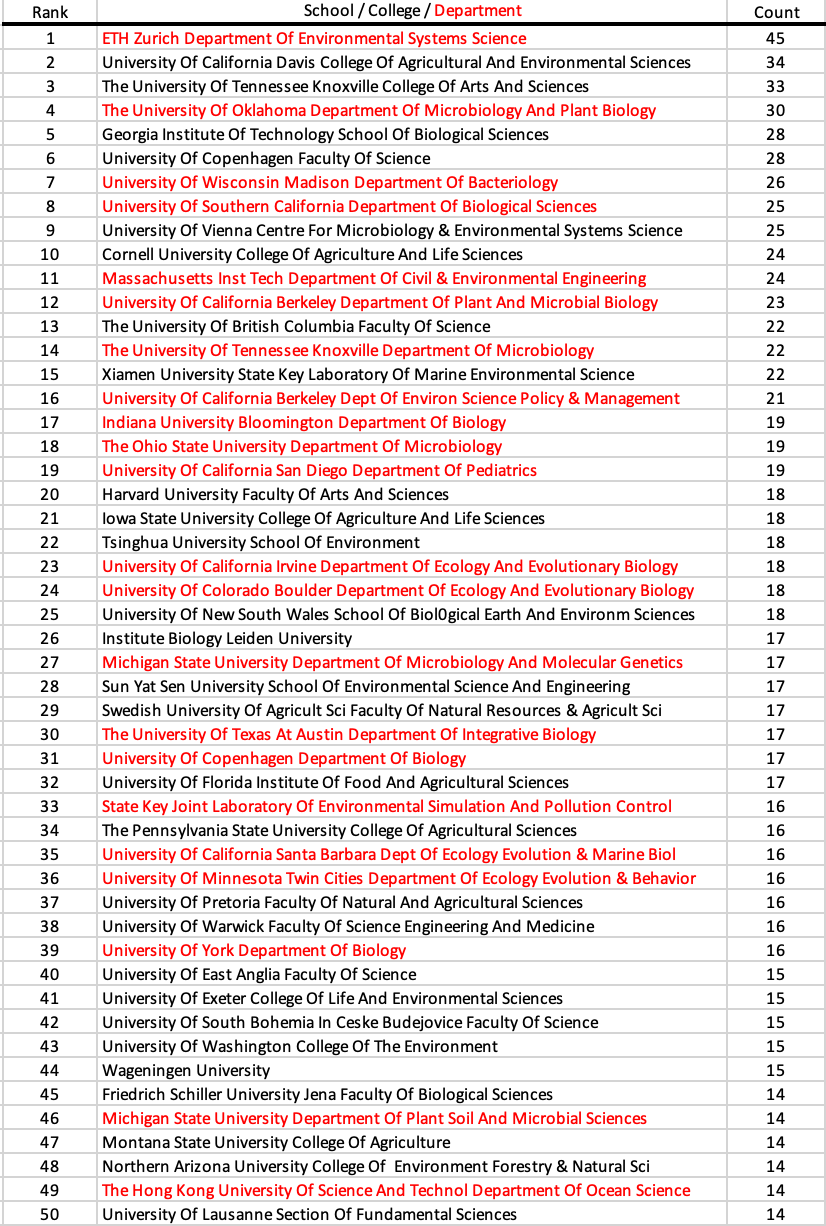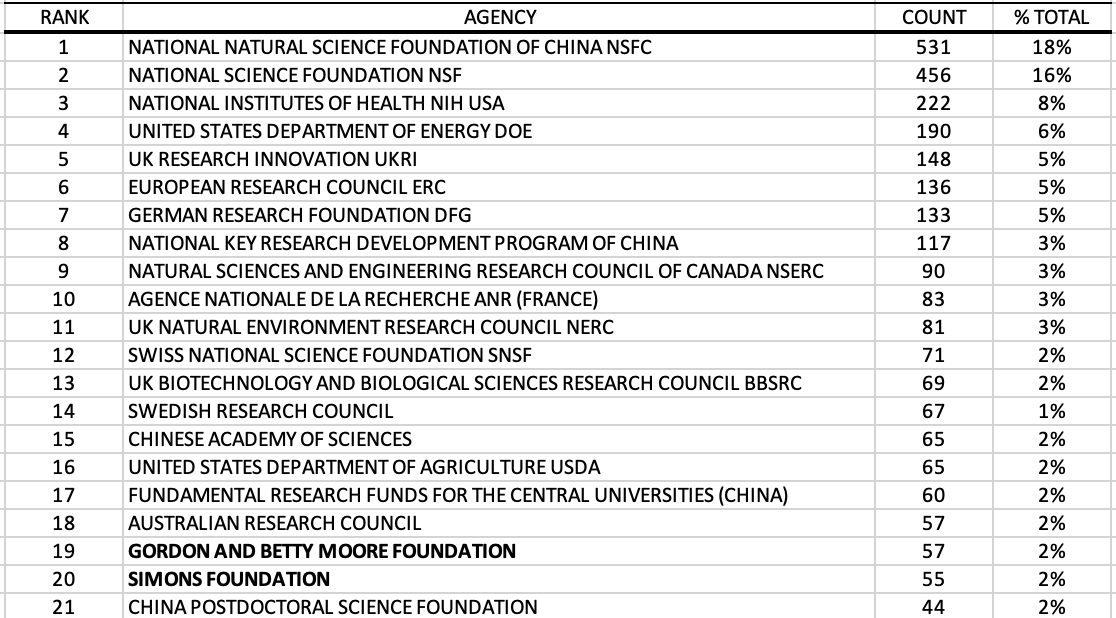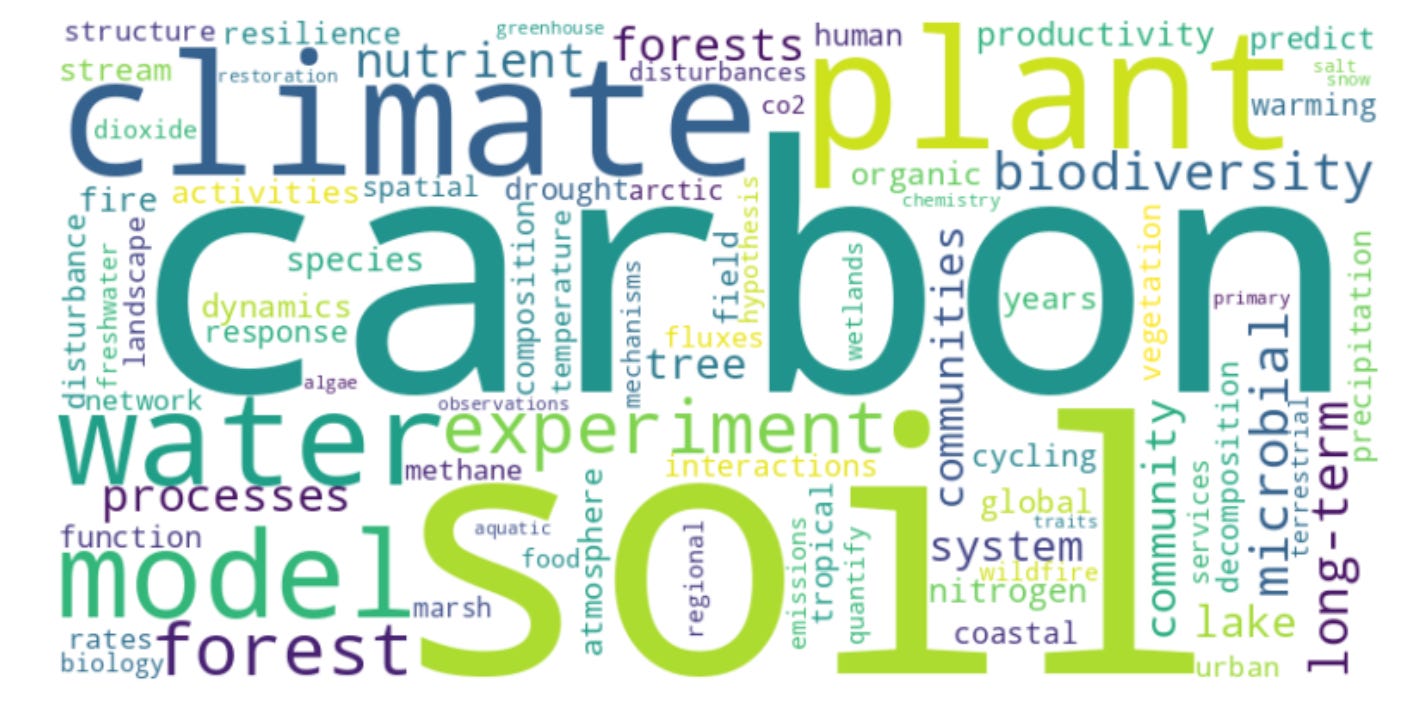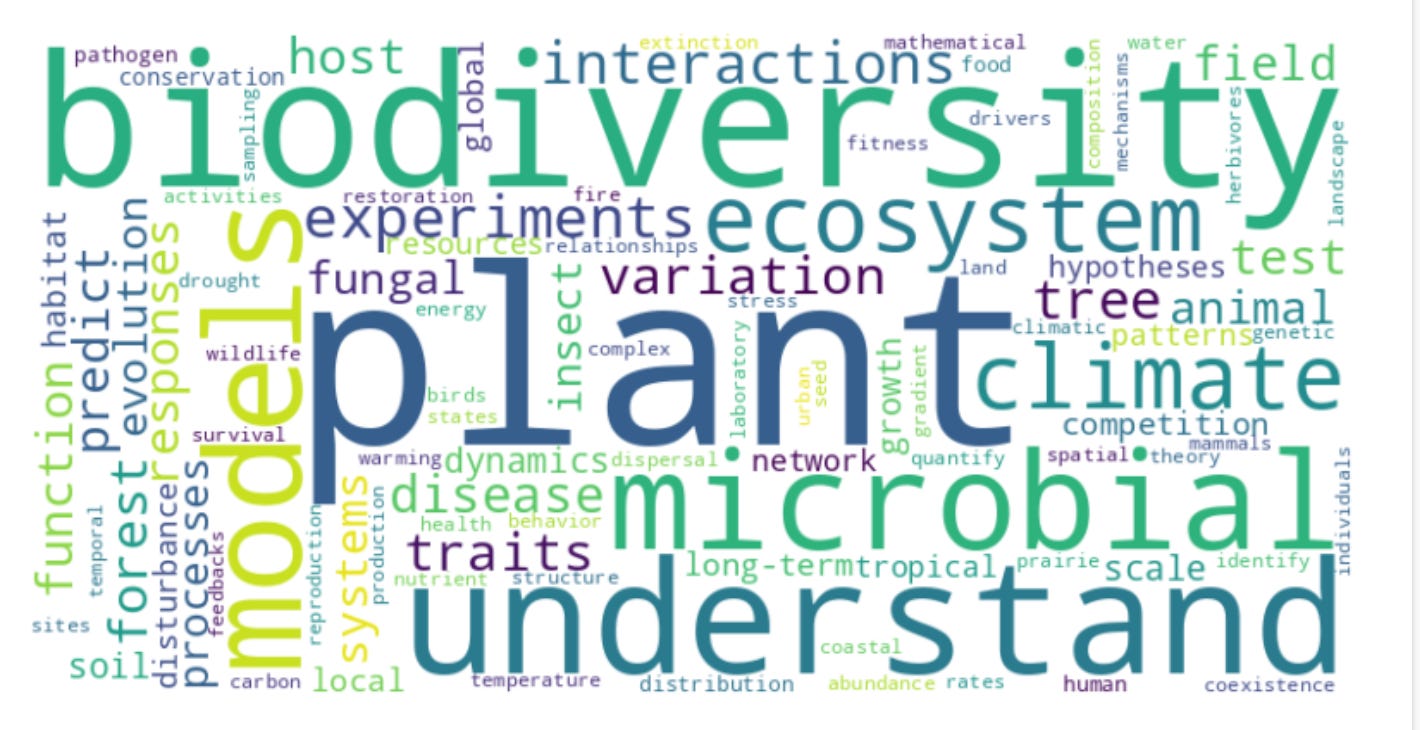The science of microbial ecology science
The “science of science” is an emerging discipline that examines how and why scientific fields develop as they do. It tries to take into account not only the available methods and technology that determine advances in scientific disciplines but also historical, social, and economic factors. One approach is scientometrics, which analyzes “big data” from databases such as Web of Science, Scopus or US NSF Awards in order to catalog who and what gets funded and gets published, who collaborates with whom and career trajectories. A recent example is an analysis of the pedigree of faculty at US universities (Wapman et al., 2022). It found that 80% of tenure-track faculty received their degrees from just 20% of Ph.D.-granting institutions and that 8 institutions (Cal-Berkeley, Harvard, Illinois, Michigan, MIT, Texas, Stanford and Wisconsin-Madison) provided 20% of all domestically-trained faculty! The relationships were similar when broken down by discrete disciplines. [N.B. I do not mean to imply that they only ‘worthy’ outcome of obtaining a Ph.D. degree is becoming a tenure track faculty member. I think this paper speaks more to identifying a bias in that system. Understanding the bases for that requires further examination.]
My analysis of microbial ecology through this lens will be shallower than much of the science-of-science literature, but represents my first step in this direction. I hope that I will be able to extend this in future posts, in particular to analyze how microbial ecology science is developing given its history, methods, and infrastructure in ways that might be different than other domains in the natural sciences and particularly its close cousins, microbiology and ecology.
The growth rate of microbial ecology
I have used Web of Science for most of my analysis, employing search terms to find published articles on microbial (Bacteria, Archaea, Algae and Fungi) ecology. Here is the increase in publications with hits from those search terms over the past 100 y. Fittingly for a microbial process, it is exponential – with a doubling time of about 8 years. This doubling time is similar to that found for all publications related to biology. The earliest papers concerned algae although I did notice a 1924 by EB Fred (microbiologist and later president at the University of Wisconsin) on the bacteria of Lake Mendota, a topic on which I worked some 50 years later!
Where is microbial ecology done?
Over the past five years, there have been approximately 30,000 papers published that mention microbial ecology according to Web of Science. These arise from 180 different countries. Note that more than 1/3 of these have at least one author from China and that 60% of the papers have an author from either China or the United States.
When it comes to specific institutions, analysis of affiliations is a bit more fraught as ‘collectives’ of academies, institutes and systems can dominate the list. I used the Web of Science “Affiliation with Department” filter – the top hits here tend to be Colleges or Faculties but do give some sense for very productive centers for microbial ecology research over the past 5 years.
The top end of microbial ecology research
Those 30,000 papers were published in about 3200 different publications. However, about 2000 of these were represented only once or twice and many of the remaining journals had aims very different than the philosophical basis for Think Like a Microbe (e.g., applied disciplines). My first idea was to restrict analysis to my so-called Top 5 journals (Ecology section of Applied & Environmental Microbiology, Environmental Microbiology, FEMS Microbiology Ecology, ISME Journal and Microbial Ecology). However, this represented only about 1500 publications which felt too restrictive. I then augmented my search with 11 other highly regarded journals associated with scientific societies to increase the yield to 3000, representing 10% of papers published over the past 5 years. Here are the top 50 affiliations of Colleges, Schools, and Departments with the departments highlighted in red to identify important foci of research.
It is quite pleasing to see that there are concentrations of microbial ecology talent as these are conducive to broad intellectually-stimulating interactions among both faculty and students which can produce novel ways of thinking about the fundamental problems in the field. I come at this from the perspective of my career in science – back in the day within a Microbiology Department if you weren’t working on Escherichia coli, Salmonella typhimurium or perhaps Bacillus subtilis, you were studying “funny bugs” and you probably were the only person in your department doing so. Your colleagues used “funny bugs” in the same pejorative sense that physicists call anything other than physics research “stamp collecting.” An important milestone in the United States was the Center for Microbial Ecology at Michigan State University, founded by Jim Tiedje in 1989 with funding from the National Science Foundation. In Germany, 2 Max Planck Institutes were begun in the early 1990s: Terrestrial Microbiology founded by Rudolph Thauer and Marine Microbiology initiated by Bo Barker Jorgensen and Fritz Widdel. These have also been exceptionally important to the development and growth of investigators who now are widely distributed contributors to the science of microbial ecology.
Who funds research in microbial ecology?
My friend Jim Prosser has taken microbial ecologists to task several times for pursuing descriptive research rather than thinking more deeply to develop hypothesis-driven research. I agree with his analysis of the problem but would lay the problem not primarily with individuals but with funding agencies. Research scientists are certainly motivated by their passion for making progress on their field of interest, but they also want a successful career. In the academic world, that means publishing papers and in a field driven by experiments using advanced technologies that means securing and maintaining research funding. [I will note here this does not leave scientists (particularly senior scientists) off the hook, as they are often intimately involved in setting agency objectives and determining which projects get funded].
For the 3000 papers published in last 5 years from my set of 16 top journals, here are the funding sources that contributed to at least 2% of those papers.
The list bears some relationship to the order of countries by number of publications. China’s NSF and the 3 major US government funding agencies (NSF, NIH, and DOE) comprise nearly 50% of the funding sources. Of note is that 2 of the entries are not government funding agencies – the Moore Foundation and the Simons Foundation. Both have been active in funding marine microbial ecology projects.
What gets funded and why
The first question can be objectively answered from databases. I downloaded information on all current projects from the US National Science Foundation’s Ecosystem Sciences Program and Population & Community Ecology Program. Within the U.S. funding structure, these are the 2 programs I would expect to be best aligned with the philosophy of Think Like a Microbe: identifying principles that have a reasonable degree of generality. From a concatenated list of abstracts (about 300 from each program – note that this was not restricted to just projects involving microbes), I extracted word frequencies which I then culled to those I thought were most representative of the topic or intellectual activity. Rather than a table, I regressed to an early 21st C convention and made a word cloud.
Ecosystem Science
Population and Community Ecology
The second question of why something get funded is more difficult and more of a sociological one. My experiences were with the U.S. funding system, primarily the National Science Foundation (NSF) and the Department of Energy (DOE) – a caveat is that my reflections are somewhat dated (as I am now 10 years out of the game). However, I hope my insights are of use to some young scientists. Dealing with the nuances of funding agencies is generally not part of one’s academic training. In the words of Omar Little, that great philosopher from the television series, The Wire, “The game is out there, and it's either play or get played.”
NSF is traditionally thought of as the “basic science” agency in which projects are driven by curiosity and discovery. DOE fashions itself as more “mission oriented” with respect to looking for science and technology solutions to energy and environmental problems. In reality, one can find “mission-oriented” elements in NSF and quite basic research projects in DOE.
It is also relevant to note the outsized impact of DOE’s Joint Genome Institute on the shift of microbial ecology research to DNA sequence-based projects. JGI was established in 1997 to work on the Human Genome Project. When that project concluded, the sequencing machines (120 at maximum) and workforce remained so DOE searched for other uses. In 2004 JGI started its Community Sequencing Program where investigators could receive large-scale sequences of genomes or metagenomes that they had sampled. In addition, DOE’s Office of Biological and Environmental Research started its Genomes to Life program in 2002 to explicitly provide research project funding for those proposing DNA-sequence based analyses of microbial ecosystems.
There is, I believe, important cultural difference between these agencies in how projects are chosen for funding. I served on review panels for each. In the case of NSF, the advisory panel is dominant. At the end of the review, the panel constructed a ranked list of projects’ priority for funding and the program officers did not deviate from that ranking. At DOE review panels, the programs officers made it quite clear at the outset that the role of the panel was “advisory” and that in the end the officers would be making the decisions on which projects to fund. In practice, this meant the officers would take into account how well “aligned” the projects were with current thinking of mission priorities (and these could change over 5 year periods). At the time I served on the NSF Ecology panel, a culturally important criterion for the panel was that the project addressed an important (theoretical) question in (macrobe) ecology. I was the only microbial ecologist on the panel, and most microbial ecologists submitting proposals at that time had a relatively weak formal training in ecology so this aspect rarely shone through in their proposals.
A few last thoughts:
Program officers are generally happy to talk to you about their program and how to best structure your proposal
It never hurts to have an experienced colleague read over your proposal and provide suggestions that might increase its “fundability.”
Persistence is necessary – NSF reports that the funding rate for Division of Environmental Biology was 25% in 2021, but I am highly skeptical of this; the percentage of grants that were likely to be funded from my review panels was no more than 10%. Hence, one cannot get discouraged by rejections – it has often struck me that success in research science has less to do with how ‘bright’ you are than how persistent you are.
The U.S. system is kind of a lottery, given these proposal success rates. So you may need multiple rounds of submission, altered versions of a central idea that can be submitted to more than one agency or program, and several different lines of research for which you can submit proposals.
Some science-of-science investigators have brought attention to whether grant funding systems favor safe research over ‘risky’ proposals (where risky is used in the speculative sense – there can be high reward but also a chance of no progress). They generally conclude this is a problem, as grant agency officers, review panelists, and principal investigators themselves act in risk-averse ways and reviewers use bibliometrics (publications and citations) as a crutch rather than in-depth analysis of novelty and merit. A particularly dramatic example of this is Dr. Katalin Kariko, who ‘failed’ in academic research but went on to develop mRNA-based vaccine against the COVID virus.
See: https://www.journals.uchicago.edu/doi/10.1086/719252
Reference
Wapman, K.H., Zhang, S., Clauset, A. et al. Quantifying hierarchy and dynamics in US faculty hiring and retention. Nature610, 120–127 (2022).https://doi.org/10.1038/s41586-022-05222-x
Your moment of Zen
The mouth of the Tagus River, Lisbon, Portugal


